Economic Stimulus and Unemployment in Australia
VerifiedAdded on 2019/11/26
|9
|1468
|302
Essay
AI Summary
The government uses expansionary monetary and fiscal policies to stimulate economic growth and reduce unemployment. This can be done by reducing corporate taxes from 30% to 25%, increasing government expenditure on infrastructure projects, or implementing tax cuts and increasing borrowing. However, these policies may have limitations, such as not being effective if consumer confidence is low, causing inflation if the economy is near full capacity, and resulting in crowding out effect in the long run.
Contribute Materials
Your contribution can guide someone’s learning journey. Share your
documents today.
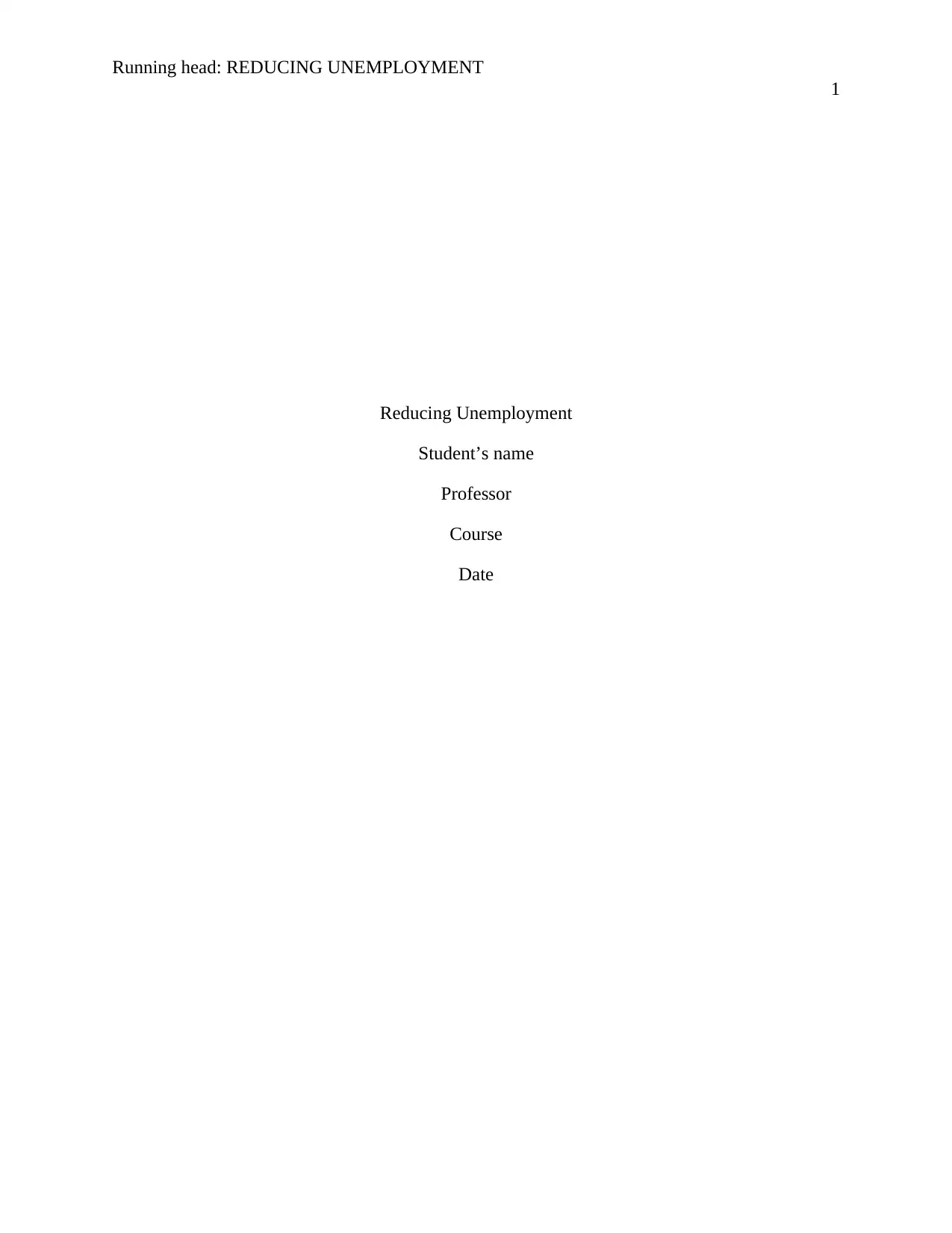
Running head: REDUCING UNEMPLOYMENT
1
Reducing Unemployment
Student’s name
Professor
Course
Date
1
Reducing Unemployment
Student’s name
Professor
Course
Date
Secure Best Marks with AI Grader
Need help grading? Try our AI Grader for instant feedback on your assignments.
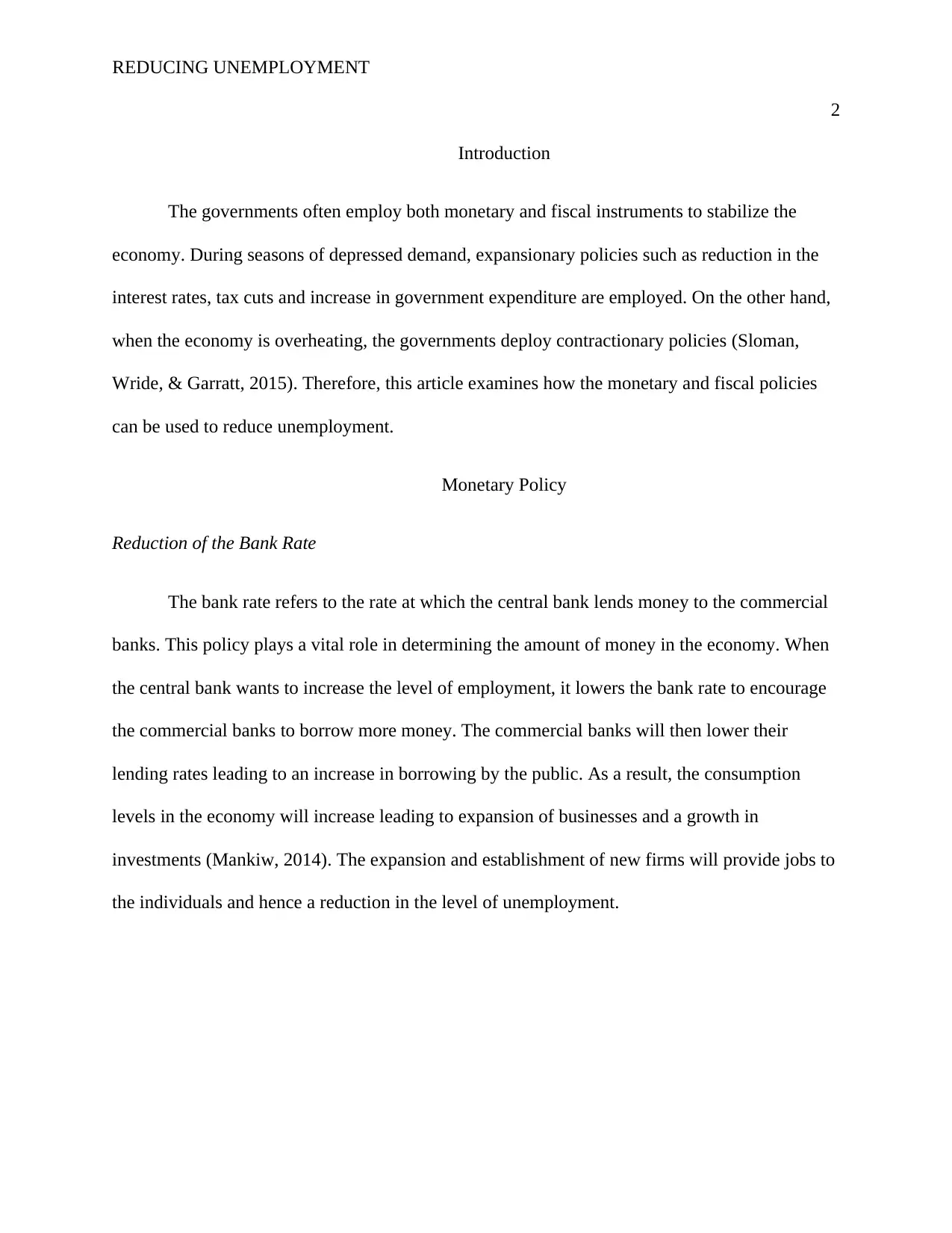
REDUCING UNEMPLOYMENT
2
Introduction
The governments often employ both monetary and fiscal instruments to stabilize the
economy. During seasons of depressed demand, expansionary policies such as reduction in the
interest rates, tax cuts and increase in government expenditure are employed. On the other hand,
when the economy is overheating, the governments deploy contractionary policies (Sloman,
Wride, & Garratt, 2015). Therefore, this article examines how the monetary and fiscal policies
can be used to reduce unemployment.
Monetary Policy
Reduction of the Bank Rate
The bank rate refers to the rate at which the central bank lends money to the commercial
banks. This policy plays a vital role in determining the amount of money in the economy. When
the central bank wants to increase the level of employment, it lowers the bank rate to encourage
the commercial banks to borrow more money. The commercial banks will then lower their
lending rates leading to an increase in borrowing by the public. As a result, the consumption
levels in the economy will increase leading to expansion of businesses and a growth in
investments (Mankiw, 2014). The expansion and establishment of new firms will provide jobs to
the individuals and hence a reduction in the level of unemployment.
2
Introduction
The governments often employ both monetary and fiscal instruments to stabilize the
economy. During seasons of depressed demand, expansionary policies such as reduction in the
interest rates, tax cuts and increase in government expenditure are employed. On the other hand,
when the economy is overheating, the governments deploy contractionary policies (Sloman,
Wride, & Garratt, 2015). Therefore, this article examines how the monetary and fiscal policies
can be used to reduce unemployment.
Monetary Policy
Reduction of the Bank Rate
The bank rate refers to the rate at which the central bank lends money to the commercial
banks. This policy plays a vital role in determining the amount of money in the economy. When
the central bank wants to increase the level of employment, it lowers the bank rate to encourage
the commercial banks to borrow more money. The commercial banks will then lower their
lending rates leading to an increase in borrowing by the public. As a result, the consumption
levels in the economy will increase leading to expansion of businesses and a growth in
investments (Mankiw, 2014). The expansion and establishment of new firms will provide jobs to
the individuals and hence a reduction in the level of unemployment.

REDUCING UNEMPLOYMENT
3
Figure 1: Source: Business Insider
The Reserve Bank of Australia has made a significant cut the cash rate since the onset of
the Global Financial Crisis (GFC). In 2007, before the GFC, the Australia’s cash rate was 7.25%.
However, when the crisis began in 2008, the Reserve Bank of Australia reduced cash rate to 3%.
This policy action, along with other fiscal instruments, helped Australia to avoid recession and
thus protected the citizens from massive employment loss that was witnessed in advanced
economies. The current cash rate stands at 1.5% (Scutt, 2017). These significant cuts in the cash
rate have had a considerable impact in stimulating different sectors of the Australia’s economy.
For example, the current boom in Australia’s housing sector is partially attributed to the low cost
of borrowing. More houses are being constructed thus providing employment opportunities to
many people.
Open Market Operations
3
Figure 1: Source: Business Insider
The Reserve Bank of Australia has made a significant cut the cash rate since the onset of
the Global Financial Crisis (GFC). In 2007, before the GFC, the Australia’s cash rate was 7.25%.
However, when the crisis began in 2008, the Reserve Bank of Australia reduced cash rate to 3%.
This policy action, along with other fiscal instruments, helped Australia to avoid recession and
thus protected the citizens from massive employment loss that was witnessed in advanced
economies. The current cash rate stands at 1.5% (Scutt, 2017). These significant cuts in the cash
rate have had a considerable impact in stimulating different sectors of the Australia’s economy.
For example, the current boom in Australia’s housing sector is partially attributed to the low cost
of borrowing. More houses are being constructed thus providing employment opportunities to
many people.
Open Market Operations
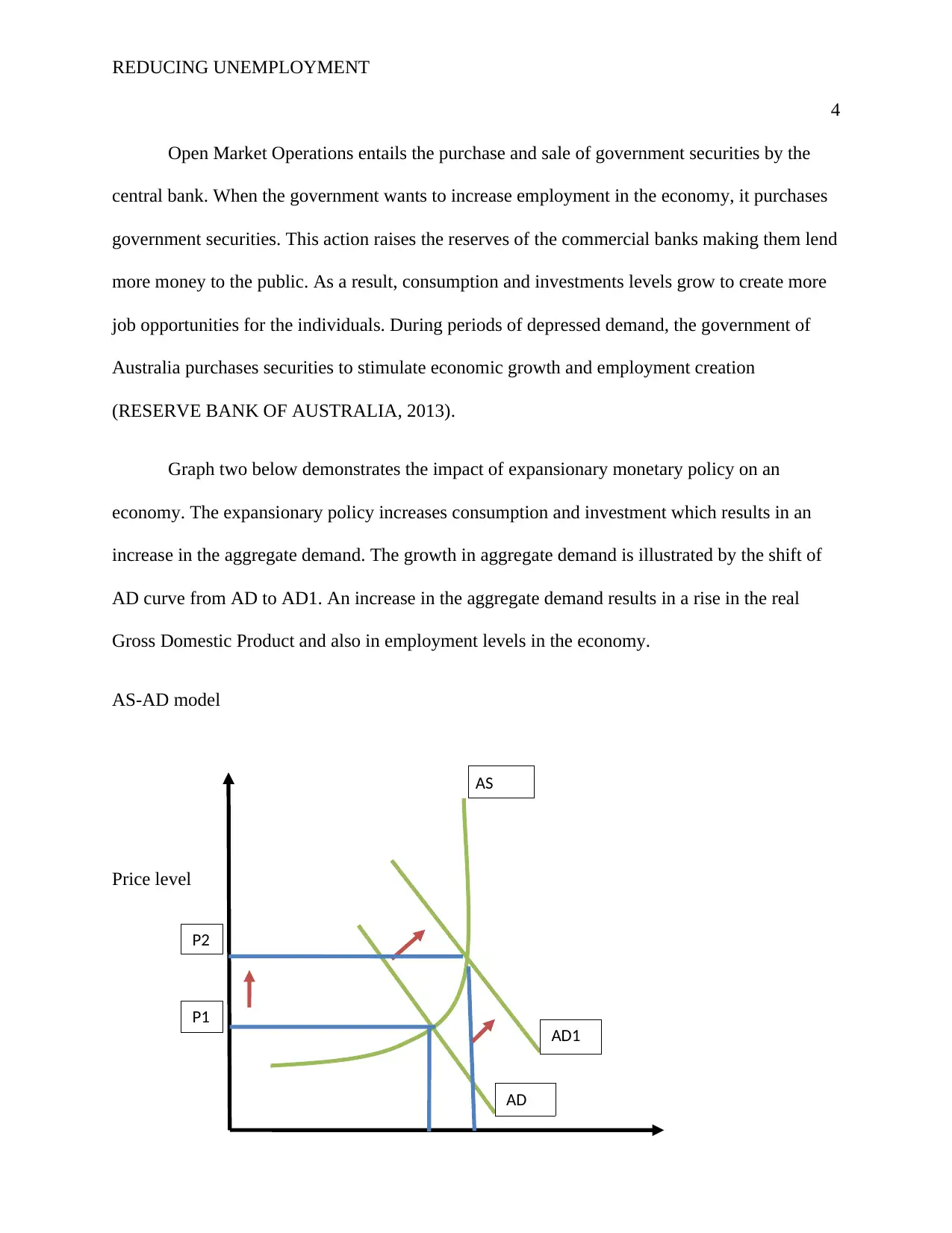
REDUCING UNEMPLOYMENT
4
Open Market Operations entails the purchase and sale of government securities by the
central bank. When the government wants to increase employment in the economy, it purchases
government securities. This action raises the reserves of the commercial banks making them lend
more money to the public. As a result, consumption and investments levels grow to create more
job opportunities for the individuals. During periods of depressed demand, the government of
Australia purchases securities to stimulate economic growth and employment creation
(RESERVE BANK OF AUSTRALIA, 2013).
Graph two below demonstrates the impact of expansionary monetary policy on an
economy. The expansionary policy increases consumption and investment which results in an
increase in the aggregate demand. The growth in aggregate demand is illustrated by the shift of
AD curve from AD to AD1. An increase in the aggregate demand results in a rise in the real
Gross Domestic Product and also in employment levels in the economy.
AS-AD model
Price level
AS
P2
P1
AD1
AD
4
Open Market Operations entails the purchase and sale of government securities by the
central bank. When the government wants to increase employment in the economy, it purchases
government securities. This action raises the reserves of the commercial banks making them lend
more money to the public. As a result, consumption and investments levels grow to create more
job opportunities for the individuals. During periods of depressed demand, the government of
Australia purchases securities to stimulate economic growth and employment creation
(RESERVE BANK OF AUSTRALIA, 2013).
Graph two below demonstrates the impact of expansionary monetary policy on an
economy. The expansionary policy increases consumption and investment which results in an
increase in the aggregate demand. The growth in aggregate demand is illustrated by the shift of
AD curve from AD to AD1. An increase in the aggregate demand results in a rise in the real
Gross Domestic Product and also in employment levels in the economy.
AS-AD model
Price level
AS
P2
P1
AD1
AD
Paraphrase This Document
Need a fresh take? Get an instant paraphrase of this document with our AI Paraphraser
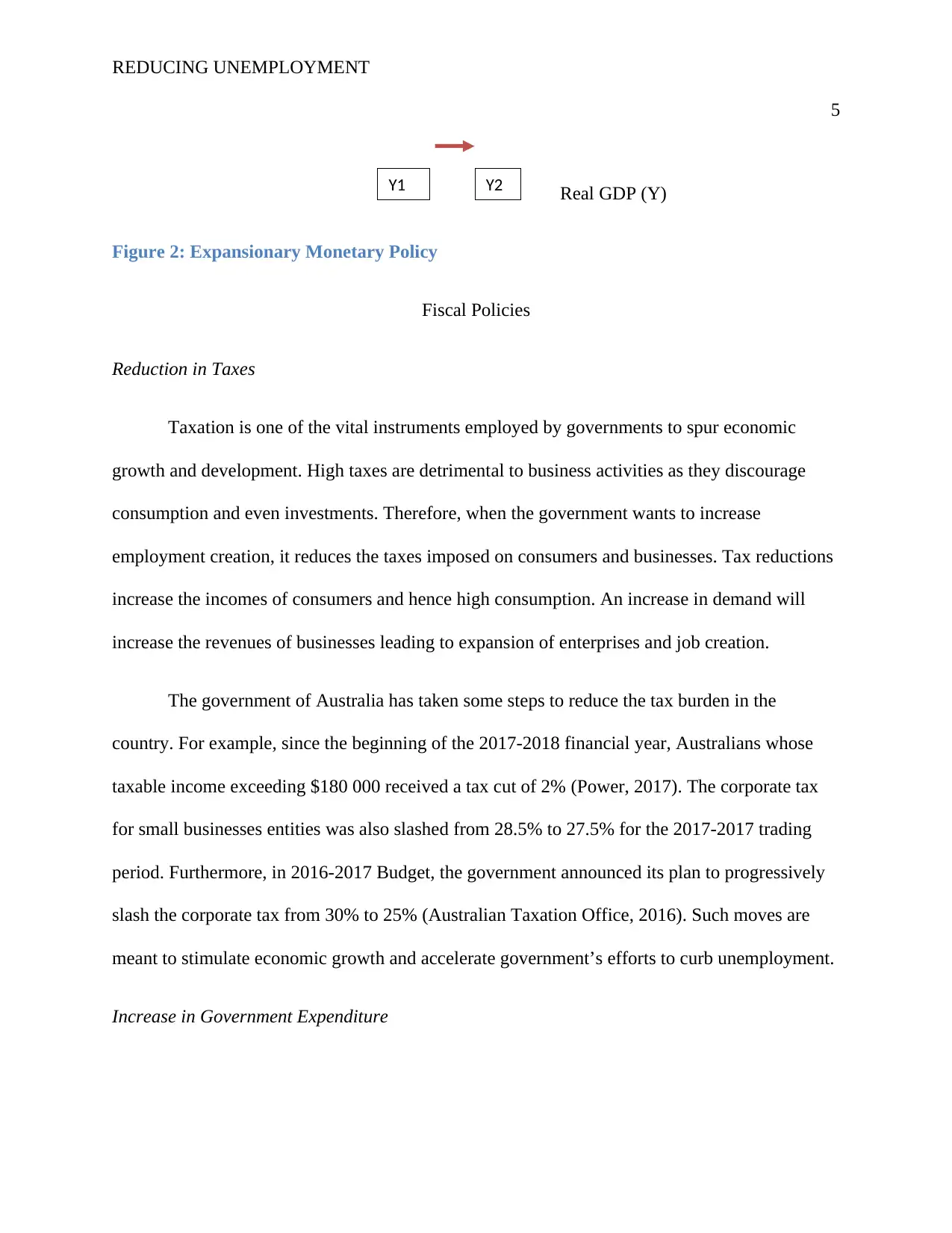
REDUCING UNEMPLOYMENT
5
Real GDP (Y)
Figure 2: Expansionary Monetary Policy
Fiscal Policies
Reduction in Taxes
Taxation is one of the vital instruments employed by governments to spur economic
growth and development. High taxes are detrimental to business activities as they discourage
consumption and even investments. Therefore, when the government wants to increase
employment creation, it reduces the taxes imposed on consumers and businesses. Tax reductions
increase the incomes of consumers and hence high consumption. An increase in demand will
increase the revenues of businesses leading to expansion of enterprises and job creation.
The government of Australia has taken some steps to reduce the tax burden in the
country. For example, since the beginning of the 2017-2018 financial year, Australians whose
taxable income exceeding $180 000 received a tax cut of 2% (Power, 2017). The corporate tax
for small businesses entities was also slashed from 28.5% to 27.5% for the 2017-2017 trading
period. Furthermore, in 2016-2017 Budget, the government announced its plan to progressively
slash the corporate tax from 30% to 25% (Australian Taxation Office, 2016). Such moves are
meant to stimulate economic growth and accelerate government’s efforts to curb unemployment.
Increase in Government Expenditure
Y1 Y2
5
Real GDP (Y)
Figure 2: Expansionary Monetary Policy
Fiscal Policies
Reduction in Taxes
Taxation is one of the vital instruments employed by governments to spur economic
growth and development. High taxes are detrimental to business activities as they discourage
consumption and even investments. Therefore, when the government wants to increase
employment creation, it reduces the taxes imposed on consumers and businesses. Tax reductions
increase the incomes of consumers and hence high consumption. An increase in demand will
increase the revenues of businesses leading to expansion of enterprises and job creation.
The government of Australia has taken some steps to reduce the tax burden in the
country. For example, since the beginning of the 2017-2018 financial year, Australians whose
taxable income exceeding $180 000 received a tax cut of 2% (Power, 2017). The corporate tax
for small businesses entities was also slashed from 28.5% to 27.5% for the 2017-2017 trading
period. Furthermore, in 2016-2017 Budget, the government announced its plan to progressively
slash the corporate tax from 30% to 25% (Australian Taxation Office, 2016). Such moves are
meant to stimulate economic growth and accelerate government’s efforts to curb unemployment.
Increase in Government Expenditure
Y1 Y2
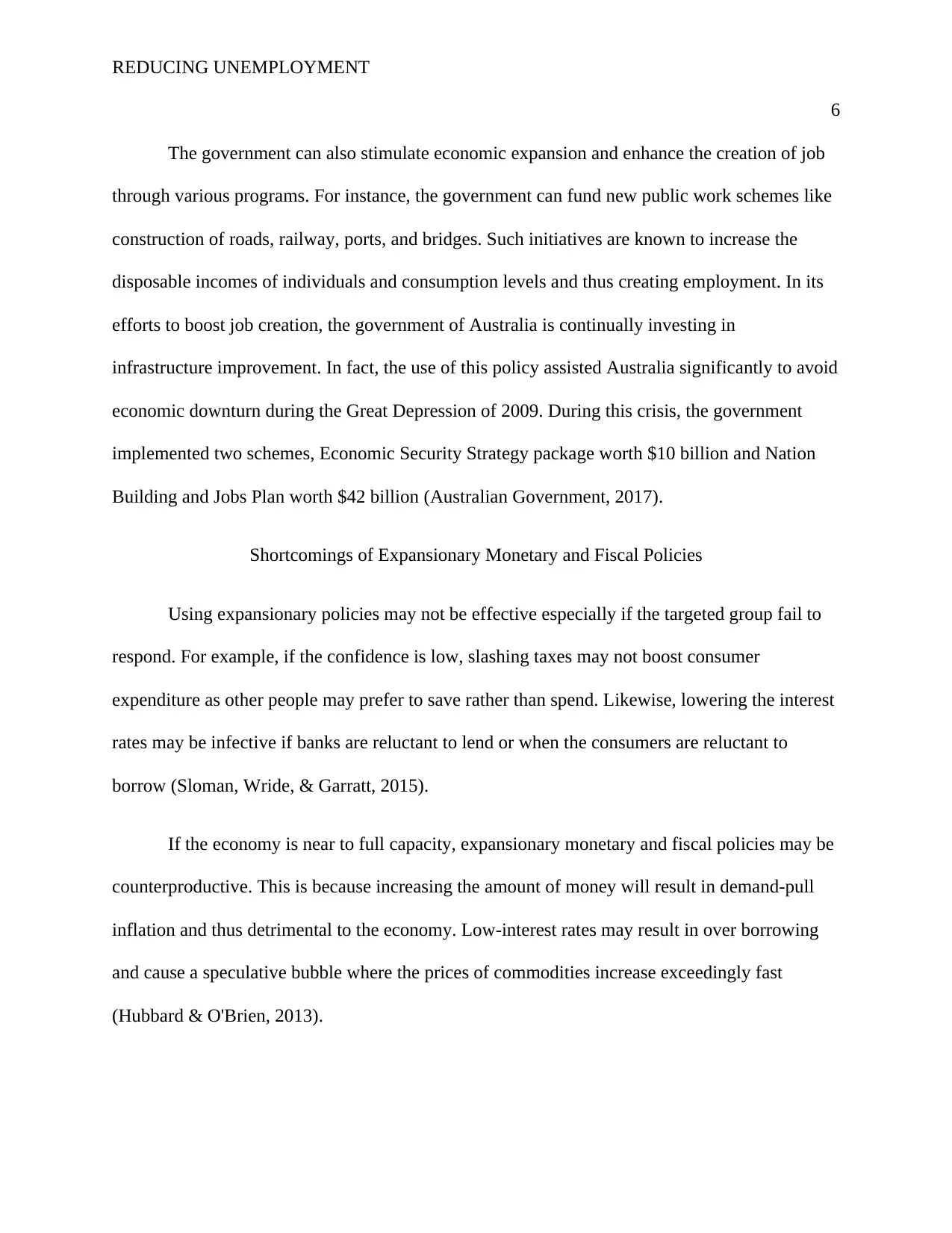
REDUCING UNEMPLOYMENT
6
The government can also stimulate economic expansion and enhance the creation of job
through various programs. For instance, the government can fund new public work schemes like
construction of roads, railway, ports, and bridges. Such initiatives are known to increase the
disposable incomes of individuals and consumption levels and thus creating employment. In its
efforts to boost job creation, the government of Australia is continually investing in
infrastructure improvement. In fact, the use of this policy assisted Australia significantly to avoid
economic downturn during the Great Depression of 2009. During this crisis, the government
implemented two schemes, Economic Security Strategy package worth $10 billion and Nation
Building and Jobs Plan worth $42 billion (Australian Government, 2017).
Shortcomings of Expansionary Monetary and Fiscal Policies
Using expansionary policies may not be effective especially if the targeted group fail to
respond. For example, if the confidence is low, slashing taxes may not boost consumer
expenditure as other people may prefer to save rather than spend. Likewise, lowering the interest
rates may be infective if banks are reluctant to lend or when the consumers are reluctant to
borrow (Sloman, Wride, & Garratt, 2015).
If the economy is near to full capacity, expansionary monetary and fiscal policies may be
counterproductive. This is because increasing the amount of money will result in demand-pull
inflation and thus detrimental to the economy. Low-interest rates may result in over borrowing
and cause a speculative bubble where the prices of commodities increase exceedingly fast
(Hubbard & O'Brien, 2013).
6
The government can also stimulate economic expansion and enhance the creation of job
through various programs. For instance, the government can fund new public work schemes like
construction of roads, railway, ports, and bridges. Such initiatives are known to increase the
disposable incomes of individuals and consumption levels and thus creating employment. In its
efforts to boost job creation, the government of Australia is continually investing in
infrastructure improvement. In fact, the use of this policy assisted Australia significantly to avoid
economic downturn during the Great Depression of 2009. During this crisis, the government
implemented two schemes, Economic Security Strategy package worth $10 billion and Nation
Building and Jobs Plan worth $42 billion (Australian Government, 2017).
Shortcomings of Expansionary Monetary and Fiscal Policies
Using expansionary policies may not be effective especially if the targeted group fail to
respond. For example, if the confidence is low, slashing taxes may not boost consumer
expenditure as other people may prefer to save rather than spend. Likewise, lowering the interest
rates may be infective if banks are reluctant to lend or when the consumers are reluctant to
borrow (Sloman, Wride, & Garratt, 2015).
If the economy is near to full capacity, expansionary monetary and fiscal policies may be
counterproductive. This is because increasing the amount of money will result in demand-pull
inflation and thus detrimental to the economy. Low-interest rates may result in over borrowing
and cause a speculative bubble where the prices of commodities increase exceedingly fast
(Hubbard & O'Brien, 2013).
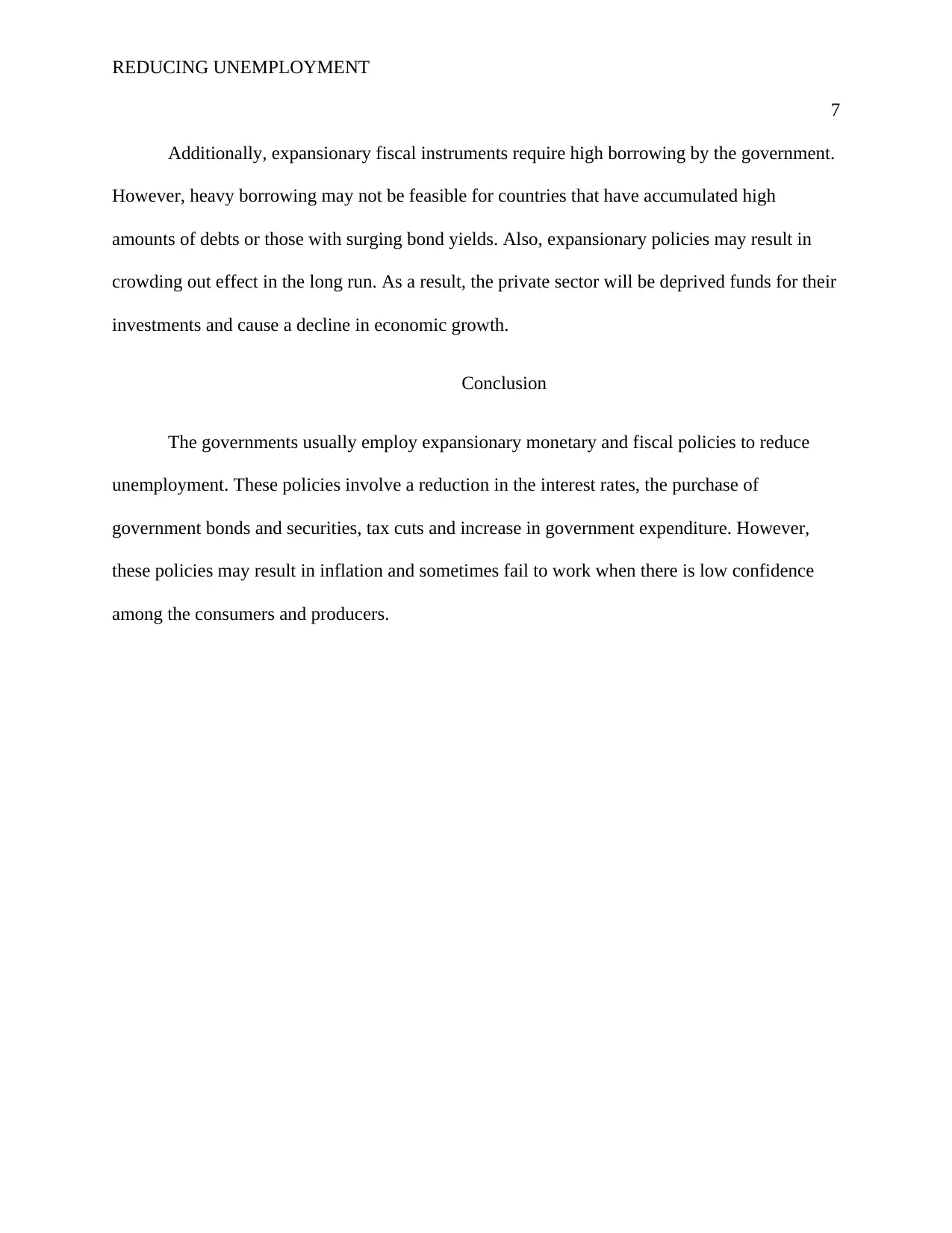
REDUCING UNEMPLOYMENT
7
Additionally, expansionary fiscal instruments require high borrowing by the government.
However, heavy borrowing may not be feasible for countries that have accumulated high
amounts of debts or those with surging bond yields. Also, expansionary policies may result in
crowding out effect in the long run. As a result, the private sector will be deprived funds for their
investments and cause a decline in economic growth.
Conclusion
The governments usually employ expansionary monetary and fiscal policies to reduce
unemployment. These policies involve a reduction in the interest rates, the purchase of
government bonds and securities, tax cuts and increase in government expenditure. However,
these policies may result in inflation and sometimes fail to work when there is low confidence
among the consumers and producers.
7
Additionally, expansionary fiscal instruments require high borrowing by the government.
However, heavy borrowing may not be feasible for countries that have accumulated high
amounts of debts or those with surging bond yields. Also, expansionary policies may result in
crowding out effect in the long run. As a result, the private sector will be deprived funds for their
investments and cause a decline in economic growth.
Conclusion
The governments usually employ expansionary monetary and fiscal policies to reduce
unemployment. These policies involve a reduction in the interest rates, the purchase of
government bonds and securities, tax cuts and increase in government expenditure. However,
these policies may result in inflation and sometimes fail to work when there is low confidence
among the consumers and producers.
Secure Best Marks with AI Grader
Need help grading? Try our AI Grader for instant feedback on your assignments.
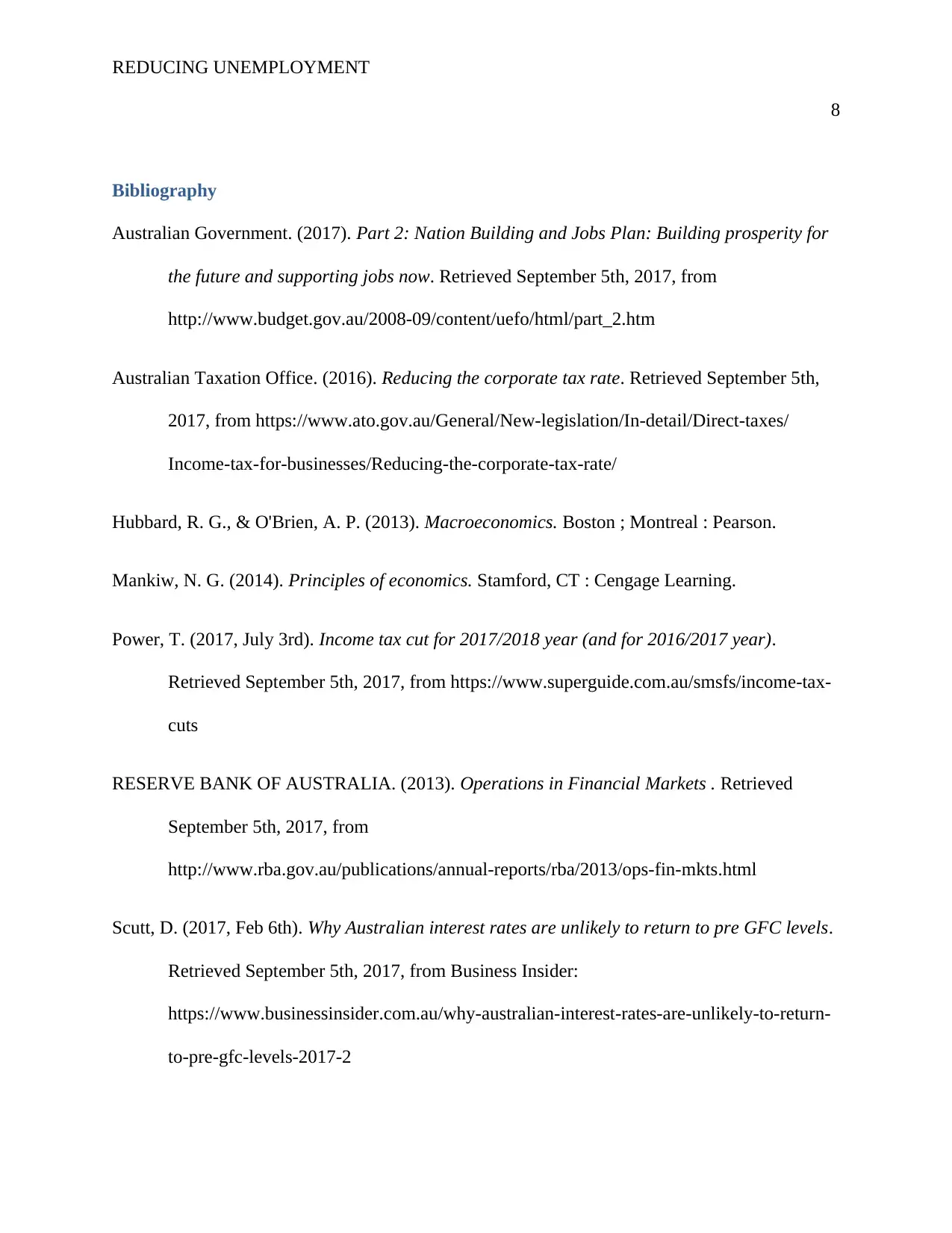
REDUCING UNEMPLOYMENT
8
Bibliography
Australian Government. (2017). Part 2: Nation Building and Jobs Plan: Building prosperity for
the future and supporting jobs now. Retrieved September 5th, 2017, from
http://www.budget.gov.au/2008-09/content/uefo/html/part_2.htm
Australian Taxation Office. (2016). Reducing the corporate tax rate. Retrieved September 5th,
2017, from https://www.ato.gov.au/General/New-legislation/In-detail/Direct-taxes/
Income-tax-for-businesses/Reducing-the-corporate-tax-rate/
Hubbard, R. G., & O'Brien, A. P. (2013). Macroeconomics. Boston ; Montreal : Pearson.
Mankiw, N. G. (2014). Principles of economics. Stamford, CT : Cengage Learning.
Power, T. (2017, July 3rd). Income tax cut for 2017/2018 year (and for 2016/2017 year).
Retrieved September 5th, 2017, from https://www.superguide.com.au/smsfs/income-tax-
cuts
RESERVE BANK OF AUSTRALIA. (2013). Operations in Financial Markets . Retrieved
September 5th, 2017, from
http://www.rba.gov.au/publications/annual-reports/rba/2013/ops-fin-mkts.html
Scutt, D. (2017, Feb 6th). Why Australian interest rates are unlikely to return to pre GFC levels.
Retrieved September 5th, 2017, from Business Insider:
https://www.businessinsider.com.au/why-australian-interest-rates-are-unlikely-to-return-
to-pre-gfc-levels-2017-2
8
Bibliography
Australian Government. (2017). Part 2: Nation Building and Jobs Plan: Building prosperity for
the future and supporting jobs now. Retrieved September 5th, 2017, from
http://www.budget.gov.au/2008-09/content/uefo/html/part_2.htm
Australian Taxation Office. (2016). Reducing the corporate tax rate. Retrieved September 5th,
2017, from https://www.ato.gov.au/General/New-legislation/In-detail/Direct-taxes/
Income-tax-for-businesses/Reducing-the-corporate-tax-rate/
Hubbard, R. G., & O'Brien, A. P. (2013). Macroeconomics. Boston ; Montreal : Pearson.
Mankiw, N. G. (2014). Principles of economics. Stamford, CT : Cengage Learning.
Power, T. (2017, July 3rd). Income tax cut for 2017/2018 year (and for 2016/2017 year).
Retrieved September 5th, 2017, from https://www.superguide.com.au/smsfs/income-tax-
cuts
RESERVE BANK OF AUSTRALIA. (2013). Operations in Financial Markets . Retrieved
September 5th, 2017, from
http://www.rba.gov.au/publications/annual-reports/rba/2013/ops-fin-mkts.html
Scutt, D. (2017, Feb 6th). Why Australian interest rates are unlikely to return to pre GFC levels.
Retrieved September 5th, 2017, from Business Insider:
https://www.businessinsider.com.au/why-australian-interest-rates-are-unlikely-to-return-
to-pre-gfc-levels-2017-2
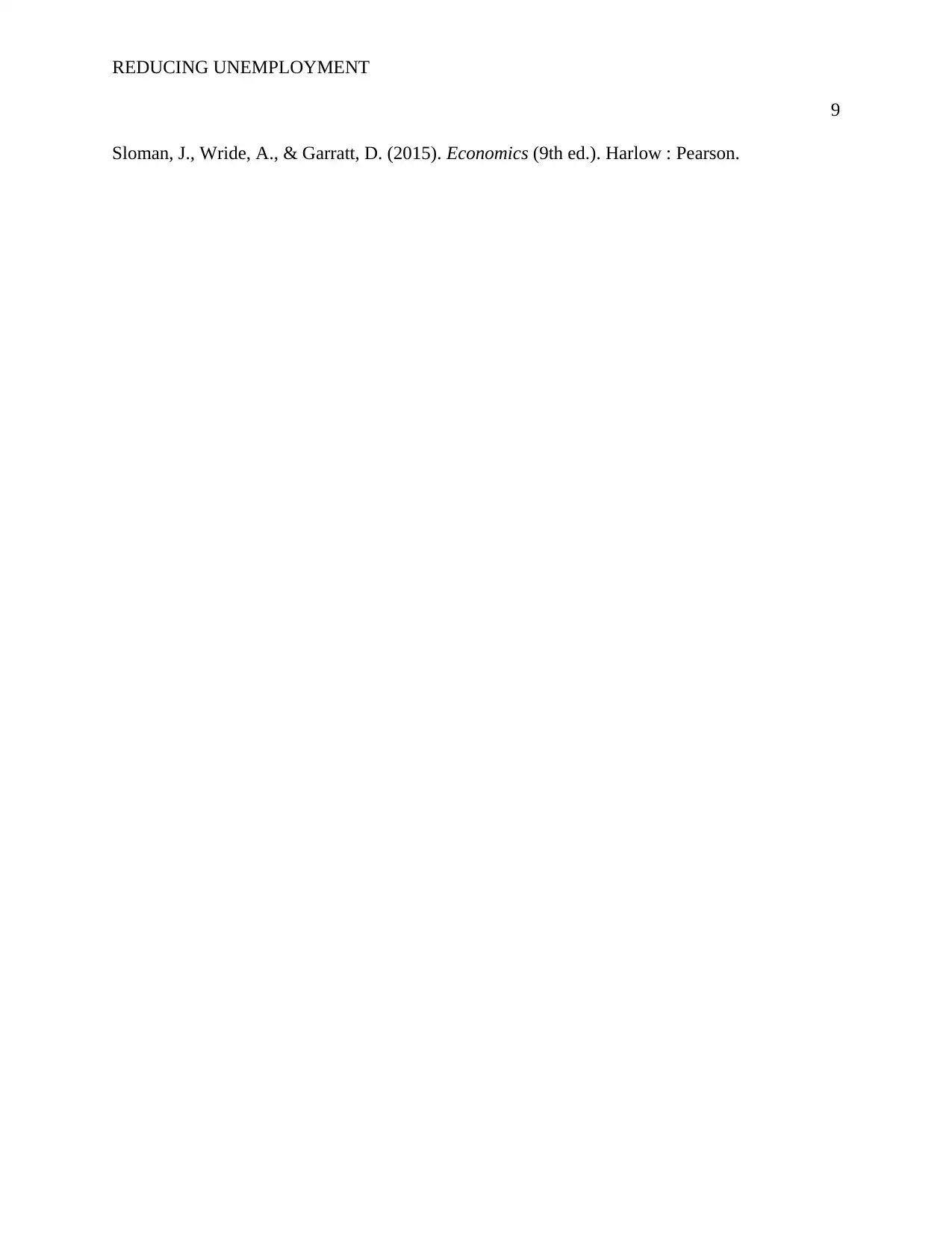
REDUCING UNEMPLOYMENT
9
Sloman, J., Wride, A., & Garratt, D. (2015). Economics (9th ed.). Harlow : Pearson.
9
Sloman, J., Wride, A., & Garratt, D. (2015). Economics (9th ed.). Harlow : Pearson.
1 out of 9
![[object Object]](/_next/static/media/star-bottom.7253800d.svg)




